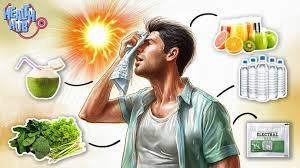Avoiding heatwaves requires staying hydrated. However, water is insufficient.
Heat-related diseases and dehydration are frequent outcomes of high heat and inadequate fluid consumption. Thirst, dry mouth, decreased urine production, dark yellow urine, and dry skin are symptoms of mild dehydration. Frequently drinking water, ingesting electrolyte-rich liquids, and eating hydrating foods are all examples of hydration methods.

As temperatures reach to record highs, certain regions of north India are suffering from one of the worst heatwaves on record.
Fueled by emissions and global warming, parts of India are currently experiencing a severe heatwave that is more than just a rise in temperature—rather, it is an unrelenting heatwave that lasts day and night.

The human body's ability to withstand heat shock is tested, and inevitably, it may start to malfunction.
The body loses vital electrolytes and water when it perspires to cool itself. The lips split, the skin gets dry, and a deep exhaustion permeates the bones. The pulse quickens, the muscles tense, and the mind becomes foggy.
It is a cry for assistance, indicating that the fluid equilibrium necessary for life needs to be restored right now.The key to preventing this is staying hydrated. This is what occurs to the body during a heatwave.
A HEATWAVE: WHAT IS IT?
A heatwave is an extended period of exceptionally hot weather, especially in nations with an oceanic climate. It may also be accompanied by significant humidity.
A heatwave is defined differently in different places, but in general, it is defined as temperatures that are much higher than the usual maximum temperature for a given area at a certain time of year.
The country's major heatwave warning was issued this summer by the Indian Meteorological Department (IMD) for Delhi, Odisha, Andhra Pradesh, Telangana, West Bengal, Uttar Pradesh, and certain areas of Karnataka.
The range of temperatures that has been observed is 41 to 50 degrees Celsius. According to science, the human body can only sustain proper operation at a maximum temperature of 42.3 degrees Celsius.
Dehydration is the first indication of a heatstroke or heat stress when the body experiences extreme heat.
When the body is overheated, it might become more difficult for it to regulate its temperature and continue operating normally. This is known as heat stress. It causes cramping in the muscles, heat exhaustion, which manifests as sweating, nausea, dizziness, and clammy skin. In the worst case, it results in heat stroke, which requires emergency care.
What's Your Reaction?






















